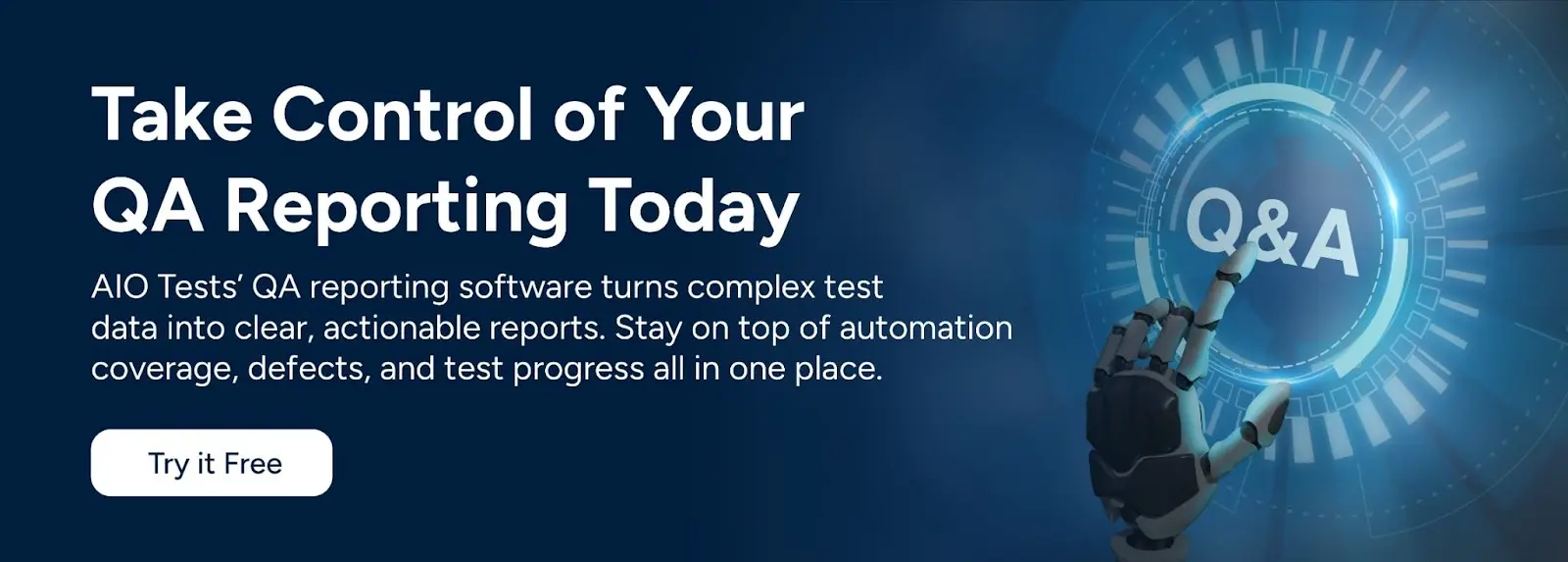
Software quality assurance teams generate a lot of test results, but the real challenge often lies in how those results are reported and shared. Spreadsheets and scattered reports slow down reviews and make it harder to spot issues quickly.
AIO Tests solves this gap with its QA reporting feature in AIO Tests, giving teams a single place to track, view, and discuss test outcomes.
The reporting feature is designed to answer the everyday questions QA leads ask:
Instead of digging through files or piecing together updates, teams get clear, organized data in real time.
This clarity helps QA managers demonstrate progress, measure effectiveness, and guide decisions with confidence. In the sections ahead, we’ll look at how AIO Tests stands out among QA testing tools by supporting test metrics automation and simplifying reporting without adding extra work.
Accurate test metrics are the foundation of effective QA reporting. Without them, it’s hard to understand whether testing is thorough, where risks exist, or how close a product is to release readiness.
Modern QA reporting software like AIO Tests helps teams capture and present these metrics across different types of software testing, ensuring the data is clear, consistent, and easy to share. For QA managers, this isn’t just about tracking pass/fail numbers. It’s about building a transparent view of testing quality that the whole team can trust.
For QA teams looking for comprehensive visibility into their testing activities, AIO Tests, one of the leading QA reporting tools, offers a robust reporting suite that serves as a single source of truth covering both manual and automated testing efforts.
With over 20+ tailored report types, the platform enables you to track essential testing metrics that support informed decision-making and maintain project health. Here’s how AIO tests reporting supports test metrics automation and helps you monitor the key metrics that matter most:
Track the creation of test cases against Jira requirements to ensure full coverage. AIO Tests helps teams write test cases effectively and monitor how thoroughly project requirements are covered, reducing the risk of missed functionality or gaps in testing.
Analyze defect trends, track the rate of defect discovery, and monitor how defects affect test cases and project requirements. AIO Tests captures these essential reporting metrics, enabling teams to prioritize issues and resolve them efficiently.
Seamlessly link test cases, executions, defects, and requirements to maintain full traceability. AIO Tests provides traceability summary and detail reports that help you confirm that every requirement is accounted for and tested.
Real-time execution reports show the status, progress, and distribution of test runs across cycles. This allows teams to measure testing velocity, identify bottlenecks, and optimize resource allocation over multiple test cycles.
Use AIO Tests’ manual and automated test management, along with automated test reporting and coverage reports, to balance your testing efforts. These insights show how much is automated and highlight areas that may still need manual testing or further automation.
Monitor overall project health metrics such as defect trends, test activity, and contributor status. These insights provide stakeholders with a clear view of testing performance and workload distribution over time.
Generate easy-to-read reports and metrics, customize them with additional fields, export in PDF or Excel formats, and schedule automated distribution to keep everyone aligned.
By using AIO Tests’ reporting features, teams gain a clear, data-centered view of their AI-assisted testing efforts, enabling them to track progress, uncover issues early, and maintain consistent test quality across projects.
Beyond tracking key QA metrics, AIO Tests provides teams with a structured approach to automation in test reporting, allowing them to create, customize, and share reports effortlessly. Instead of manually building spreadsheets, reports are neatly categorized and supported with features that make them easier to use, update, and distribute.
Reports in AIO Tests are grouped into categories so QA leads can quickly find the insights they need:
Once generated, reports are easy to refine and share:
AIO Tests’ QA reporting software provides teams with a clear, structured way to track and share test results without relying on spreadsheets or manual compilation. Among QA reporting tools, AIO Tests stands out by combining detailed reporting with practical usability.
Teams can review project health, track recurring issues, and compare testing cycles quickly, helping managers make informed decisions and allocate resources where they are needed most. With this tool, QA reporting becomes organized, consistent, and actionable.
Book a demo for AIO Tests today and experience how smarter reporting can transform your QA process.

With AIO Tests, creating a QA report is simple and organized. You select the test cycles or projects, choose the report type, and customize the fields you want to include. The platform generates structured reports in PDF or Excel that you can share directly with your team.
AIO Tests allows you to automate reporting directly within Jira. You set up report templates and criteria, and the platform updates them automatically as new test data comes in. Reports can also be scheduled and shared with team members without manual intervention.
Manual reporting involves collecting test results and building reports by hand, which can be slow and error-prone. Automated reporting with AIO Tests pulls data directly from Jira, organizes it, and updates reports in real time. This ensures faster, more accurate insights and reduces the workload on QA teams.